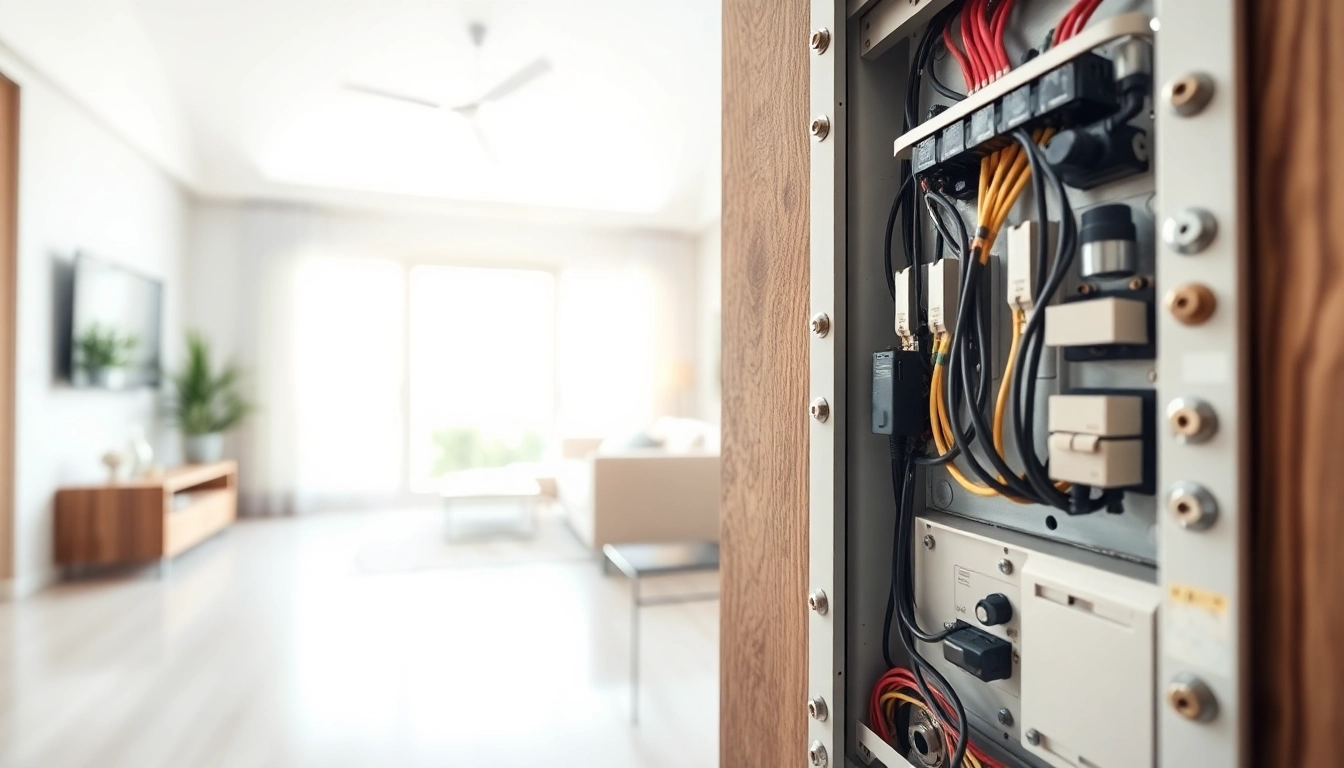Essential Facts About Electrical Panel Upgrade: Benefits and Considerations
Understanding Electrical Panel Upgrade
What is an Electrical Panel Upgrade?
An electrical panel upgrade involves replacing or modifying the main distribution board of a home, which serves as the central hub for electrical power. This panel connects to the utility supply and branches out to power all circuits throughout the home. Upgrading your electrical panel typically means increasing its capacity, typically from 100 amps to 200 amps or more, thereby accommodating more extensive electrical needs. This process may involve not just the physical panel but also enhancements to wiring and circuit breakers to meet modern safety standards.
Importance of Upgrading Your Electrical Panel
Upgrading your electrical panel is vital for several reasons. As homes become smarter with more electronic devices, electrical demands increase significantly. An outdated panel may not handle the load of modern appliances, which can lead to safety hazards such as overheating and electrical fires. Furthermore, an upgraded panel ensures compliance with local electrical codes and improves overall energy efficiency, potentially reducing energy costs.
Common Reasons for an Electrical Panel Upgrade
There are multiple reasons homeowners consider an Electrical Panel Upgrade. These include:
- Increased Power Needs: With the rise of home technology such as electric vehicle chargers, HVAC systems, and smart home devices, many homes require a higher amperage.
- Old Electrical Systems: Homes with wiring from the 1960s or earlier may have panels that can’t safely accommodate modern electrical demands.
- Frequent Breaker Trips: If you often experience tripped breakers, it may indicate that your panel is overloaded and needs upgrading.
- Home Renovations: Upgrading your panel is typically necessary when undertaking significant renovations that add new electrical appliances or fixtures.
- Insurance and Resale: An upgraded panel can enhance home value and may be a requirement for insurance purposes during the sale of the property.
Benefits of an Electrical Panel Upgrade
Increased Electrical Capacity Explained
One of the primary advantages of upgrading your electrical panel is the increased electrical capacity. Traditionally, older panels have maximum capacities of 100 amps. By upgrading to a 200-amp panel, homeowners can handle more circuits, thus supporting advanced appliances and multiple electronic devices without being left with inadequate power supply. This additional capacity is vital as it promotes a more efficient power flow and minimizes the risk of electrical shortages.
Safety Improvements from Upgrading Your Panel
Safety is another paramount benefit of upgrading your electrical panel. Older panels can lack modern safety technologies such as circuit breakers that trip during overloads, leading to potential fire hazards. A newer panel will feature enhanced safety devices and meet the latest electrical codes, significantly reducing the risks associated with electrical failures. Additionally, upgrades can also integrate ground fault circuit interrupters (GFCIs) and arc fault circuit interrupters (AFCIs), further protecting against electrocution and fires.
Impact on Home Value with an Electrical Panel Upgrade
Upgrading the electrical panel can greatly affect your home’s resale value. A modern, upgraded panel signifies to potential buyers that the home is safe, functional, and prepared for current technology. Many real estate agents recognize electrical upgrades as a high-return investment, often encouraging homeowners to take this step before listing their properties. Thus, investing in an electrical panel upgrade can not only enhance day-to-day comfort and safety but also provide a cost-effective solution when selling the home.
Cost Factors in Electrical Panel Upgrade
Average Costs of Upgrading Electrical Panels
The cost to upgrade an electrical panel varies widely depending on several factors, such as the panel’s amperage, the complexity of the installation, and regional labor costs. On average, homeowners can expect to spend between $800 and $4,000 on an upgrade. This includes the price of the panel itself, which ranges from $100 to $500, and labor costs, which can go from $50 to $120 per hour. It’s advisable for homeowners to obtain multiple estimates to ensure they find a qualified contractor at a competitive rate.
Labor Costs: What to Expect?
Labor costs are a significant portion of the overall expenses related to an electrical panel upgrade. Depending on the electrical contractor’s experience and the complexity of the upgrade, labor might account for $400 to $2,500 of the total project cost. It’s essential to understand that cheaper isn’t always better. Experience, knowledge of local codes, and past customer satisfaction should heavily influence the selection of your electrical contractor. Make sure the electrician is licensed, bonded, and insured to protect yourself during the upgrade process.
Additional Expenses to Consider During Upgrade
In addition to direct labor and panel costs, various additional expenses can arise during an electrical panel upgrade:
- Permit Fees: Many localities require permits for electrical work, which can be an extra $100 to $300 depending on state and local regulations.
- Upgraded Wiring: If the existing wiring is not up to code or has insufficient capacity, rewiring might be necessary, adding to the overall cost.
- Meter Upgrade: In some cases, the utility company may require a new meter, leading to additional fees.
- GFCI and AFCI Installation: Installing additional safety features like GFCI or AFCI breakers can increase the overall investment.
Process of Upgrading Your Electrical Panel
Steps for an Electrical Panel Upgrade
Upgrading an electrical panel is a multi-step process involving careful planning and execution. Here’s a general outline of the steps involved:
- Assessment: Begin by assessing your current electrical load and future needs. This should ideally be done by a qualified electrician who can provide insight into required upgrades.
- Choosing a New Panel: Select a panel that fits both your current and anticipated needs. Typically, a 200-amp panel is recommended for most homes.
- Permit Acquisition: Obtain necessary permits from local building authorities as required.
- Power Shut-Off: The utility company should disconnect power before the upgrade, ensuring safety during the entire process.
- Removal of the Old Panel: Carefully remove the existing panel and inspect associated wiring.
- Installing the New Panel: Install the new panel and connect it to the existing wiring, along with any necessary updates to wires and breakers.
- Inspection: Schedule an inspection with local authorities to ensure compliance with safety codes.
- Power Restoration: Once everything is confirmed safe and up to standard, restore the power.
- Testing: Finally, test circuits and ensure everything operates correctly to complete the project.
Choosing the Right Electrician for the Job
Selecting a competent electrician is crucial for a successful upgrade. When looking for an electrician, consider the following tips:
- Check Credentials: Ensure the electrician is licensed and insured. This protects you from liability in case of accidents.
- Seek Referrals: Ask friends, family, or neighbors for recommendations and read online reviews to gauge customer satisfaction.
- Get Multiple Estimates: Obtaining estimates from several electricians allows you to compare pricing and scope of work.
- Ask About Experience: Ensure that the electrician has specific experience with panel upgrades, as it requires a distinct skill set compared to other electrical work.
- Verify Warranty/Reliability: Excellent electricians often provide warranties for their work, ensuring you’re protected in case of issues post-installation.
Permits and Regulations in Electrical Panel Upgrade
Compliance with local laws and regulations is invaluable in the electrical panel upgrade process. Most cities and towns require permits for electrical work to ensure safety and adherence to building codes. Before beginning any work:
- Contact Local Authorities: Contact your local building department to determine specific requirements for electrical upgrades.
- Understand Electrical Codes: Familiarize yourself with local electrical codes that dictate how electrical systems must be installed and maintained.
- Plan Ahead: Include potential permit fees in your budget to avoid unexpected costs later.
- Schedule Inspections: Plan for required inspections at various stages in the project to ensure compliance with safety standards.
FAQs about Electrical Panel Upgrade
How Often Should You Upgrade Your Electrical Panel?
The frequency of electrical panel upgrades largely depends on the age of your home and your electrical needs. Generally, it is wise to consider upgrading every 20 to 30 years, especially if you have made significant changes to your home or added high-demand appliances. Regular inspections can help identify when an upgrade is necessary.
What Should You Look for in an Electrician?
When selecting an electrician for your upgrade, look for someone who is licensed, insured, and experienced, especially in panel upgrades. Check for reviews and references, ensuring they deliver quality service. Clear communication about costs, timelines, and scope of work is equally important to ensure a smooth upgrade process.
Available Incentives for Electrical Panel Upgrades
Homeowners may be eligible for various incentives and rebates when upgrading their electrical panels, particularly for energy-efficient modifications. Check with your utility company for any available programs. Additionally, certain local, state, or federal energy efficiency programs may offer tax credits or rebates that can alleviate some of the costs associated with electrical upgrades.








Post Comment